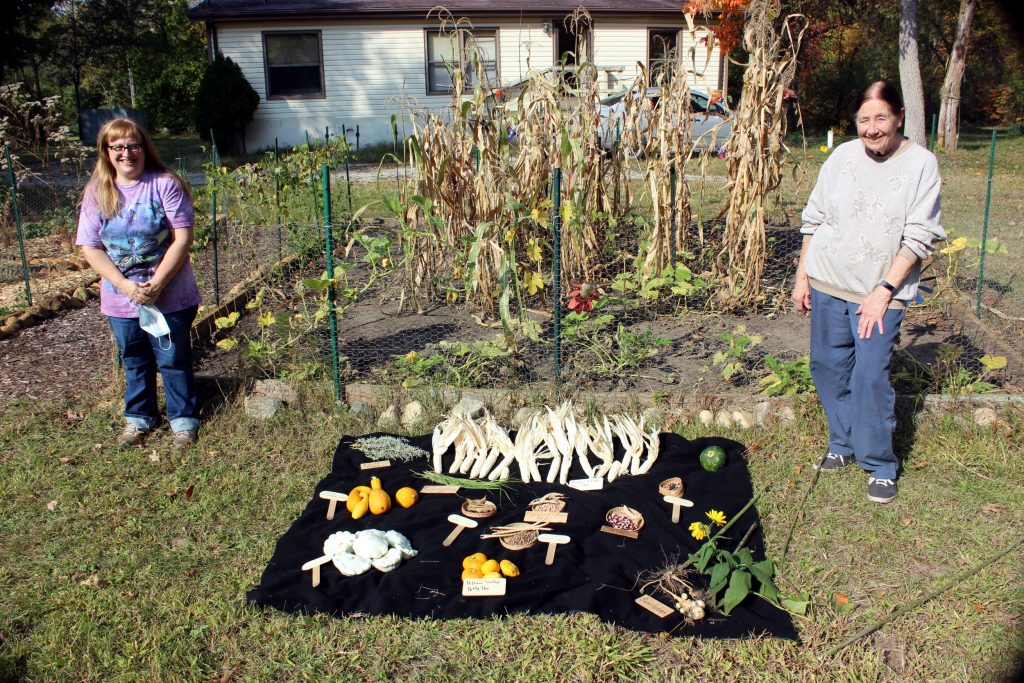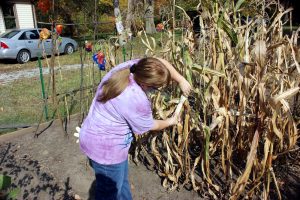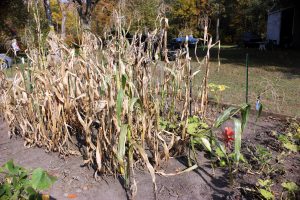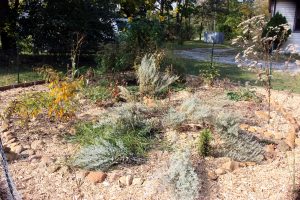It’s hard to believe that fall is here and the farmers are busy bringing in their crops. Our volunteers Cindy Deardorff and Judy Judge have been harvesting and gathering seeds from our Collier Lodge Native Gardens too.
The three sister’s garden and native plant medicine wheel garden did fairly well considering the hot dry summer we had. Cindy and Judy watched the gardens carefully and watered them when needed.
We added the following new plants: Prairie Blazingstar, Rough Blazingstar, Royal Catchfly, Partridge Pea and Bearberry bush to our wheel garden.
At the three sister’s garden, the following was planted:
Miami White flour corn, – Seed was received from the U.S. national Plant Germplasm System in Ames, Iowa. The Miami were known for growing white seed corn. When ground it resembled wheat flour. Jacques-Charles de Sabbrevois de Bleury was commander at Detroit from 1715-1717. Wrote this about the Miami: The women were very industrious and raise a kind of Indian corn which is unlike that of our tribes at Detroit. Their corn is white of the same size as the other with much finer husks and much whiter flour.
Eariv Yellow Summer Crookneck – This is one of the oldest documented varieties of squashes. Dating back from around the 1700’s and possibly earlier. Thomas Jefferson raised this squash at Monticello. It is the only squash that can be documented to the Lenape People.
White & Yellow Bush Scallop or Patty Pans – Date from pre-Columbian times. This is another early known squash grown by the American Indians of the eastern United States. The natives called this “Symnel” or Cymling” Very popular during colonial times. It has even appeared in a painting from 1591.
Potawatomi Lima Beans (Pole) – Lima beans are a very old documented New World bean traceable to Mexico and Peru. The Spanish brought this bean to Florida and traded among the Indian nations and probably traded up to the Potawatomi.
Seneca Indian Bear Paw (Pole),-This is a runner bean that has red flowers attracting humming birds. It is also known as the Scarlet runner bean dating back to 1750. This variety is known to come from the Iroquois nation, Seneca.
Potawatomi Rabbit Bean (Pole) – native name “Owamawin” This seed is actually in the cow-pea family. From the Potawatomi Reservation in Kansas. It may have come from the Potawatomi scouts that went into Mexico in the 1800’s or from the Spanish bringing it from Africa and traded to the native nations.
Potawatomi/Miami Bean (Pole) -18th, early 19th century Indiana shell bean. This bean is in the same family as the speckled cranberry beans which is a very common native bean from the East coast to the Great Lakes region with slight variations in sized and coloration of beige & red markings.
Seneca Sunflower – A sunflower with medium to large seed heads with seeds in mixed sizes and colors. The Seneca traditionally crushed the seeds in a mortar and boiled them to extract the oil. The darker seeds were used in dyes. Seeds were used in many native food dishes.
Sunchokes (Jerusalem Artichokes) – These are in the sunflower family and are native to North America. Samuel Champlain, a French explorer was given them to eat in 1605 by natives. Tubers are the best to harvest after the first frost. The tubers look like small knobby potatoes that can be eaten raw, boiled and baked. Some native sites have been found because these were found growing in the area.






